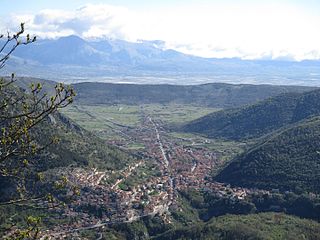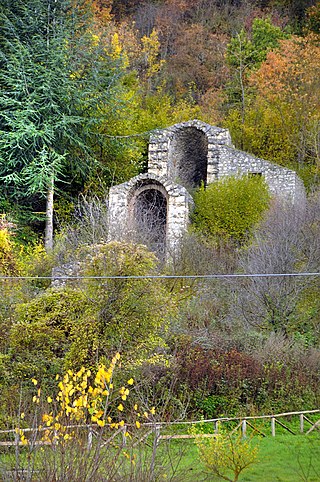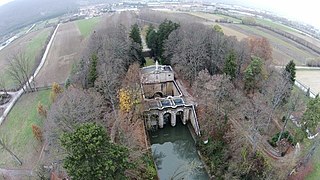
The province of L'Aquila is the largest, most mountainous and least densely populated province of the Abruzzo region of Italy. It comprises about half the landmass of Abruzzo and occupies the western part of the region. It has borders with the provinces of Teramo to the north, Pescara and Chieti to the east, Isernia to the south and Frosinone, Rome and Rieti to the west. Its capital is the city of L'Aquila.

Avezzano is a city and comune with a population of 40,864 inhabitants, situated in the Abruzzo region, province of L'Aquila, Italy. It is the second most populous municipality in the province and the sixth in the region. Avezzano was documented as an existing urban center in the ninth century. The city was destroyed by the earthquake of 1915. It was rebuilt after the 1944 Allied bombing. The city was decorated with the silver medal for civil merit, an award granted by the Italian Republic.

Aielli is a comune and town in the Province of L'Aquila in the Abruzzo region of Italy. It is located in the plain of the former Lake Fucino, in the Marsica.

Capistrello is a comune and town in the province of L'Aquila in the Abruzzo region of central-southern Italy. It is located at the border between the upper Liri River valley and the Marsica. Capistrello borders the following municipalities: Avezzano, Canistro, Castellafiume, Filettino (Frosinone), Luco dei Marsi, Scurcola Marsicana and Tagliacozzo.

Castellafiume is a comune and town in the Province of L'Aquila in the Abruzzo region of central Italy.

Civitella Roveto is a comune and town in the province of L'Aquila in the Abruzzo region of central Italy.

Ortona dei Marsi is a comune and town in the province of L'Aquila in the Abruzzo region of central Italy. It is included in traditional area of Marsica. The commune is part of the National Park of Abruzzo, Lazio and Molise. Ortona dei Marsi is situated on 1000 meters above sea level and the mountains that surround the valley reach up to 1,800 meters.

Marsica is a geographical and historical region in Abruzzo, central Italy, including 37 comuni in the province of L'Aquila. It is located between the plain of the former Fucine Lake, the National Park of Abruzzo, Lazio and Molise, the plain of Carsoli and the valley of Sulmona.

The Orsini-Colonna castle is a castle in Avezzano, Province of L'Aquila (Abruzzo).

The Terni–Sulmona railway is a regional railway line in central Italy, managed by Rete Ferroviaria Italiana. It links three regions, Umbria, Lazio and Abruzzo, and three provincial capitals: Terni, Rieti and L'Aquila. Together with the Sulmona–Isernia railway it forms a north–south corridor through the Apennines in central Italy. Its route is the result of two unfinished railways that had to meet in Rieti: the Pescara–L'Aquila–Rome line, and the Terni–Avezzano–Roccasecca line.

Avezzano concentration camp was an Italian assembly and detention camp set up in 1916 in Avezzano, Abruzzo, during World War I, immediately after the 1915 Marsica earthquake that almost completely destroyed it, decimating the population. The camp was reserved to about 15,000 prisoners from the Austro-Hungarian army, mainly of Czech–Slovak, Polish, German, and Hungarian nationalities; Romanians, who were gathered in the Romanian Legion of Italy by the end of the conflict, had a garrison and a training camp in Avezzano. Mostly abandoned in 1920, a sector was reused in World War II to house British, Indian and New Zealand prisoners of war.

Monte Salviano is a massif in the Abruzzo Apennines, Central Italy. It includes the peaks of Monte d'Aria, Monte Cimarani and Monte San Felice. Since 1999 the area, falling within the municipal territory of Avezzano, has been included in the Riserva Naturale di Monte Salviano.

The Piani Palentini is a plateau in upper Marsica, a subregion of Abruzzo, in central Italy.

Muzio Febonio was an Italian priest and historian, best known for his historical and hagiographic works about Marsica, the Abruzzo sub-region where he was born. In his writings he made extensive use of archive documents and historiographic and archaeological sources, showing a deep knowledge of them, although in a somewhat formal and pedantic style. However, his works represent a valuable source of information for later historians, even if their publication occurred with a lot of errors and delays, which partly explains the limited fame this author enjoyed.

The Tunnels of Claudius consist principally of a 6 km-long tunnel together with several monumental service tunnels which Roman Emperor Claudius had built by 52 AD to partially drain the Fucine Lake in Abruzzo, protecting riparian villages from floods and creating agricultural land. It was a massive engineering project involving 30,000 workmen and slaves who completed it in just 11 years, and considered among the grandest in antiquity. It was the longest tunnel ever built until the inauguration of the Fréjus Rail Tunnel in 1871.

The Fucine Inlet is a monument built on the head of the main emissary of the Fucine Lake in Italy. It is made up of the three-arched bridge of the sluice gates and the about 7-metre-high (23 ft) statue of the Immaculate Conception rising above. It is situated in Borgo Incile, a locality south of the city of Avezzano, in the Fucine plain, Abruzzo, Central Italy. The facility, necessary for the drainage of the Fucine Lake, connects the outer drainage canal to the underground emissary which is served by the system of the Tunnels of Claudius in Mount Salviano. The monument was made in 1876 by architect Carlo Nicola Carnevali.

The Riserva Naturale di Monte Salviano or Riserva naturale guidata Monte Salviano is a nature reserve in Abruzzo, Italy, established in 1999. It lies in the territory of the comune (municipality) of Avezzano, in the Province of L'Aquila. The reserve is named after Monte Salviano, a massif that extends northwest to southwest dividing the Fucine basin from the Palentine Plains, in the Marsica sub-region.

The Valle Roveto or Val Roveto is an Apennine valley, located in the Abruzzo Apennines, in the province of L'Aquila, in Marsica, a geographical and historical central Italian region. The Valley is crossed by the river Liri and is part of the larger Valle del Liri.
Alfredo Lucio Esposito, also known under the pseudonym of Alfredo Fiorani, was an Italian poet, writer, essayist and man of letters.

The history of Tocco da Casauria traces its origins to the foundation of the first settlement of Interpromium in ancient times. After the disappearance of that settlement in the Middle Ages, the present town of Tocco was formed, developing around the two most important town buildings as a result of a succession of rivalries between the Abbey of San Clemente a Casauria, to which the territories of Tocco belonged de jure, and lords of Germanic origin who attempted to usurp them by force.






















